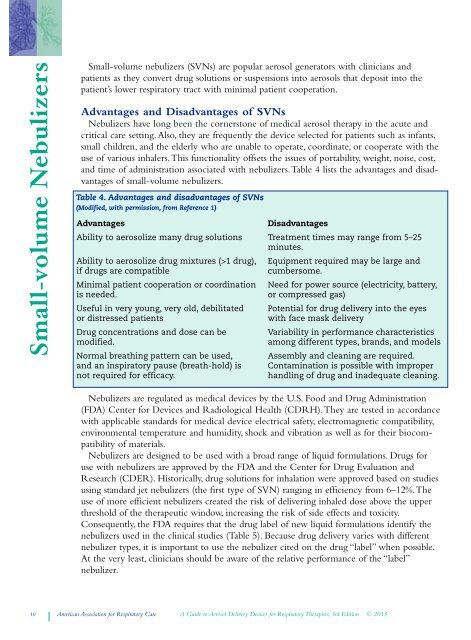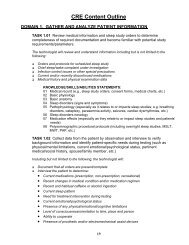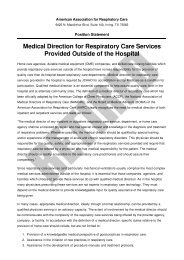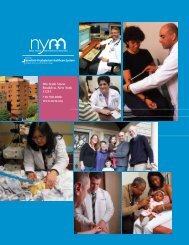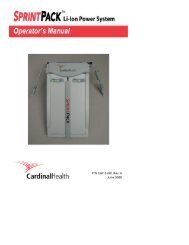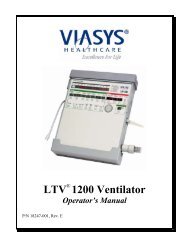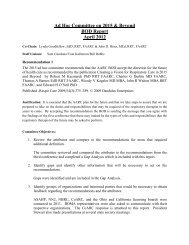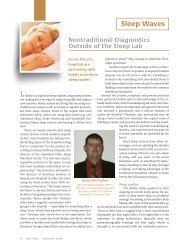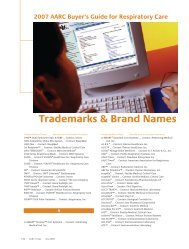Aerosol Guide - AARC.org
Aerosol Guide - AARC.org
Aerosol Guide - AARC.org
Create successful ePaper yourself
Turn your PDF publications into a flip-book with our unique Google optimized e-Paper software.
Small-volume Nebulizers<br />
Small-volume nebulizers (SVNs) are popular aerosol generators with clinicians and<br />
patients as they convert drug solutions or suspensions into aerosols that deposit into the<br />
patient’s lower respiratory tract with minimal patient cooperation.<br />
Advantages and Disadvantages of SVNs<br />
Nebulizers have long been the cornerstone of medical aerosol therapy in the acute and<br />
critical care setting. Also, they are frequently the device selected for patients such as infants,<br />
small children, and the elderly who are unable to operate, coordinate, or cooperate with the<br />
use of various inhalers. This functionality offsets the issues of portability, weight, noise, cost,<br />
and time of administration associated with nebulizers. Table 4 lists the advantages and disadvantages<br />
of small-volume nebulizers.<br />
Table 4. Advantages and disadvantages of SVNs<br />
(Modified, with permission, from Reference 1)<br />
Advantages<br />
Disadvantages<br />
Ability to aerosolize many drug solutions Treatment times may range from 5–25<br />
minutes.<br />
Ability to aerosolize drug mixtures (>1 drug), Equipment required may be large and<br />
if drugs are compatible<br />
cumbersome.<br />
Minimal patient cooperation or coordination Need for power source (electricity, battery,<br />
is needed.<br />
or compressed gas)<br />
Useful in very young, very old, debilitated Potential for drug delivery into the eyes<br />
or distressed patients<br />
with face mask delivery<br />
Drug concentrations and dose can be<br />
Variability in performance characteristics<br />
modified.<br />
among different types, brands, and models<br />
Normal breathing pattern can be used, Assembly and cleaning are required.<br />
and an inspiratory pause (breath-hold) is Contamination is possible with improper<br />
not required for efficacy.<br />
handling of drug and inadequate cleaning.<br />
Nebulizers are regulated as medical devices by the U.S. Food and Drug Administration<br />
(FDA) Center for Devices and Radiological Health (CDRH). They are tested in accordance<br />
with applicable standards for medical device electrical safety, electromagnetic compatibility,<br />
environmental temperature and humidity, shock and vibration as well as for their biocompatibility<br />
of materials.<br />
Nebulizers are designed to be used with a broad range of liquid formulations. Drugs for<br />
use with nebulizers are approved by the FDA and the Center for Drug Evaluation and<br />
Research (CDER). Historically, drug solutions for inhalation were approved based on studies<br />
using standard jet nebulizers (the first type of SVN) ranging in efficiency from 6–12%. The<br />
use of more efficient nebulizers created the risk of delivering inhaled dose above the upper<br />
threshold of the therapeutic window, increasing the risk of side effects and toxicity.<br />
Consequently, the FDA requires that the drug label of new liquid formulations identify the<br />
nebulizers used in the clinical studies (Table 5). Because drug delivery varies with different<br />
nebulizer types, it is important to use the nebulizer cited on the drug “label” when possible.<br />
At the very least, clinicians should be aware of the relative performance of the “label”<br />
nebulizer.<br />
10 American Association for Respiratory Care A <strong>Guide</strong> to <strong>Aerosol</strong> Delivery Devices for Respiratory Therapists, 3rd Edition © 2013


